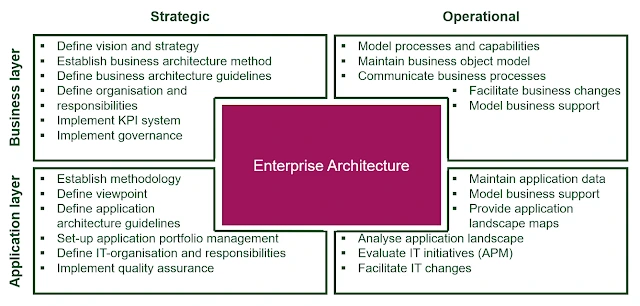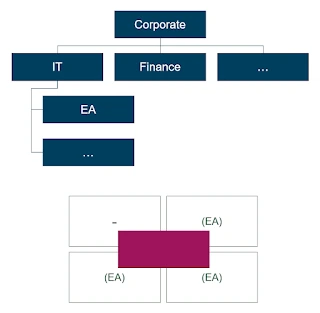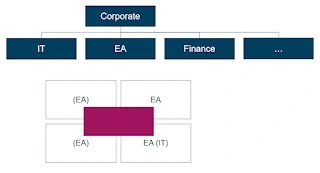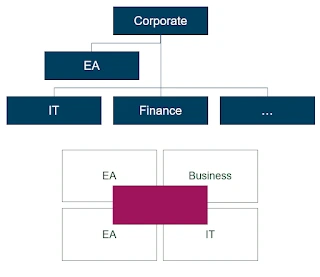Who says ignorance is bliss? Ignorance is the main reason why Enterprise Architecture fails in an organisation.
More specifically, organisational ignorance is the main cause of the continuous immaturity of Enterprise Architecture within an organisation. That is, if you’re lucky… Usually, it is this ignorance that leads to a complete failure of Enterprise Architecture.
I have discussed Enterprise Architecture’s misplacement before (in a healthcare environment), but given the gravity of the situation, I find it necessary to do so again.
Because organisations continue to dogmatically cling to a learned view of what they think Enterprise Architecture means, they are unable to adapt to the development Enterprise Architecture has undergone these past decades. As a result, the field of architecture continues to be seen as part of the IT department. With dire consequences.
So much more than just IT
Admittedly, the profession of architecture was put on the map in the late 1980s by John Zachman (known for the development of the Zachman Framework) and had a very infrastructural approach. However, in the years since, the profession has evolved considerably. What initially originated from the infrastructure angle has matured with the adoption and inclusion of the application/data architecture layer as well as the business architecture layer. The addition of these two layers of architecture has created what we know today as Enterprise Architecture.
Consultancy agencies know best
I briefly mentioned the ignorance of organisations as the main reason for the failure of Enterprise Architecture in an organisation. In addition, the finger can also be pointed at the large(r) consultancy agencies. They too are stuck in a view that is several decades old. In their diversity of target operating models, the consultancy giants only name the term architecture because they are insufficiently capable of giving it more meaning. They do not know how to distinguish between the different roles that the field of architecture has and so architecture is tucked away under a department that the consultancy agencies have been taught belongs there: the IT department.
Unfortunately, these consultancy agencies are often the advisory body for unwitting organisations.
Tasks of the Enterprise Architect
If you look at the tasks of an architect and would represent them in a quadrant model across the axes of (vertically) strategic and operational and (horizontally) business and IT, the model below emerges.

This model depicts the tasks of an Enterprise Architect. The positioning of the architect within the organisation then determines the tasks an architect can perform. There is a direct link between incorrect positioning and the failure of Enterprise Architecture to mature within an organisation.
Enterprise Architecture is supposed to be a corporate staff department where it can be descriptive and prescriptive, but also an enabler for changes, standards and guidelines for all the other departments.
Placement under IT

When the architecture function is positioned under an IT unit, it is clear to see that there is no connection with the business at the strategic level. Architecture does not have the authority to flesh out an organisation’s strategy from within the IT unit. Architecture is too far removed from the business and therefore completely disconnected from it. It is not possible to understand business processes, capabilities and objects, which means that the scope of architecture is permanently limited to the application landscape and the underlying technology. The IT landscape will do the only thing it can do: grow into an opaque chaos of disconnected applications. An unmanageable whole.

Placement as a separate unit from IT
By positioning architecture as a separate unit alongside departments such as IT, Finance, HR, etc., the option to perform Enterprise Architecture outside the boundaries of IT becomes available. It is now possible to collaborate with business people and alignment can be created with IT. On the other hand, by becoming a unit on the same level as IT, it creates a situation where architecture cannot give constraints or guidance to other departments as it is acting at the same level.
Placement under the CEO (or Board of Directors)

Only when positioned directly under the CEO is it possible to properly practice Enterprise Architecture and ensure that strategy is translated into an appropriately aligned IT environment. The strategic/business quadrant can be addressed, business and IT alignment is made possible because activities can now be carried out from a strategic perspective and an organisation-wide governance can be implemented. Positioning the architecture capability directly under the CEO maximises the business impact of Enterprise Architecture.
Correctly positioning of Enterprise Architecture within an organisation is critical to the success and scope of the capability.
One would assume that the word enterprise somewhat gives away the correct placement of Enterprise Architecture in the organisation… If not positioned at a corporate level, how else would an organisation-wide governance be possible? Enterprise Architecture is obviously a strategic capability, which clearly defines its place within the organisation.
Nevertheless, it will take several years – and possibly even several decades – for this picture to penetrate organisations to a sufficient extent.







Leave a Reply